
![]()
- HOME >
- Guide On Insects >
- Mosquitoes
Mosquitoes
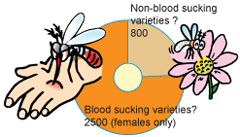 Q: Are there all sorts of different mosquitoes?
Q: Are there all sorts of different mosquitoes?
Do they all live by sucking blood from animals?- A: There are approximately 3200 species of mosquito in the world today. About 80 species carry diseases.
It is generally thought that all mosquitoes suck blood, however the truth is that a quarter of all mosquito varieties do not suck blood. What’s more, there is a widely held belief that the principal food source for mosquitoes is blood, however both males and females feed mainly on nectar from flowers. Blood from animals or humans serves as the nutrient source for maturing mosquito eggs, thus it is only the females that feed on blood. 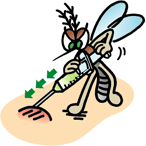 Q:Why does it itch when bitten by a mosquitoe?
Q:Why does it itch when bitten by a mosquitoe?- A: When mosquitoes bite people, they inject anaesthetic agents and anti-clotting agents along with their saliva. When the saliva comes into contact with skin, it causes an allergic reaction, and this is the cause of the itchiness that occurs when we get bitten.
- Q:I’m worried because there are so many mosquitoes near my house. What should I do? Where do you find large numbers of mosquitoes?
- A: Well, first of all, let’s take a closer look at what sort of conditions are necessary for mosquitoes to live reproduce, and what sort of habitats they prefer.
Mosquito Ecology
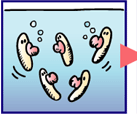 Mosquitoes lay eggs in drainage ditches, garden ponds and other areas with still water.
Mosquitoes lay eggs in drainage ditches, garden ponds and other areas with still water. 2-5 Days: Larva are born, and grow by consuming bacteria and other food sources in water.
2-5 Days: Larva are born, and grow by consuming bacteria and other food sources in water.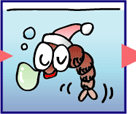 7-10 Days: After shedding their skin four times, they become a type of chrysalis.
7-10 Days: After shedding their skin four times, they become a type of chrysalis.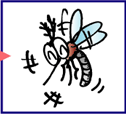 At around thirteen days, they become fully grown adults(imagos).
At around thirteen days, they become fully grown adults(imagos).Principal Breeding Grounds
A: Mosquitoes are often found in grassy places, bushes, and places where water collects. Drainage ditches, empty cans, old tyres, dark places, and places that have poor ventilation all provide ideal breeding grounds for mosquitoes. Other sources of mosquitoes include saucers under flowerpots on balconies and outdoor fishbowls.
 Drainage ditches
Drainage ditches puddles・swimming pools
puddles・swimming pools old tyres
old tyres bamboo groves
bamboo groves stumps
stumps
Habitat and time of activity differ from species to species, however the important point is that they all lay eggs in places that have water. It's important to avoid creating any watery areas in places where there are already mosquitoes. This will prevent them from laying eggs. Buckets, empty cans, old tyres, and little pools of water in gardens can all provide suitable areas for mosquitoes to breed, so its important to make every effort to turn these objects upside-down and prevent water accumulating.
Although these things may seem like trivialities, it is possible to control mosquito outbreaks by following this advice.A Primer on Harmful Insects
1. How are mosquitoes able to distinguish people?Mosquitoes are capable of distinguishing between different colours, smells, and temperatures. In addition, they have compound eyes. Mosquitoes can only see things up to a distance of 30cm, however they are very perceptive of moving objects. If you wave your hand around to try to get rid of mosquitoes, this is effectively saying "I'm over here!". Aedes mosquitoes (striped mosquitoes) are active in the daytime, and are able to distinguish between 3 different colours. Mosquitoes like the colour black, thus will approach people who are wearing this colour. In addition, they are able to distinguish people by their breath, carbon dioxide released from their skin, and the smell of sweat. They can sense differences in temperature, and tend to approach people with a high body temperature.
2. What is the upper altitude limit that mosquitoes can fly to? What floor of a building can they get up to?As mosquitoes cannot fly properly at wind speeds over 2m per second, they cannot fly up to the windy upper floors of buildings.
Having said this, they can ascend to the upper levels of a building by getting into elevators at the same time as people do, thus it is not possible to say that there will definitely be no mosquitoes on higher levels, no matter how high up the building you go.3. What kind of people are prone to getting bitten by mosquitoes?Mosquitoes sense carbon dioxide and sweat given off through people's skin, and home in on the source.
As they are capable of detecting tiny differences in carbon dioxide concentration, they are more likely to approach people who have even slightly higher levels of carbon dioxide secretion than normal.
After drinking, the level of carbon dioxide in breath increases, and this increases the likelihood of getting bitten.